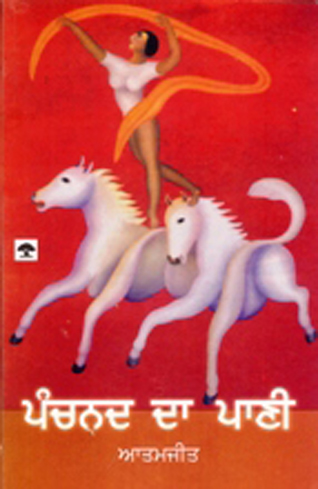Film/Stage
Atamjit Singh Play Explores Pre-Sikh History Of Punjab:
Panchnad da Paani
by PARUL BAJAJ
"It's rare that we have Punjabi theatre productions that go back to the pre-Sikh period. We can’t dismiss our history, for we are linked with it. But we need to learn from it and analyse it again for a better understanding,” said playwright and theatre director Atamjit Singh, as he oversaw the rehearsals of Panchnad Da Paani ("The Waters of the Land of The Five Rivers").
Written by him 14 years ago, Dr. Atamjit Singh - a Sahitya and Sangeet Natak Akademi award winner - agrees that it’s taken him longer to stage the play, for it was a script that needed “courage, time and resources” in order to be shaped into a production.
The play is based upon two historical short stories written by Manmohan Singh Bawa.
Set in 13th century Punjab, it depicts the struggles of the time when the Mongols were regularly attacking Punjab and the territory was being defended by the Turks, with the local Rajput rulers standing by as mere spectators.
“According to the history, the elder daughter of Rana Ran Mal Bhatti of Samana, Punjab, was taken away forcibly by the Mongols. The most dramatic situation arose when Ghazi Malik, the Governor of Punjab, asked for the hand of the second daughter of Bhatti in marriage for his brother Rajab Ali.
"A Rajput can’t think of accepting such a proposal but his daughter created history by marrying Ali,” explains Atamjit Singh.
Taking the story forward, Panchnad Da Paani encompasses a variety of issues that border on feminism, saint vs. sinner, good vs. evil, Sufism, communism and regionalism.
“The ruling class is one category and those who are ruled, another. They have their own characteristics and that’s the divide, not religion. While researching for this play, along with historians, I gained so much insight into the social history of Punjab, the reality of the times gone by and the plight of the ordinary man, and how things haven’t changed much for the oppressed even today,” says Atamjit Singh, adding that the play is a serious attempt to make the scene of contemporary Punjabi theatre more vibrant, exhilarating and respectful.
As a playwright, he has sought to create dialogue at multiple levels, with the complex web of personal, social, artistic relationships being the core of his dramatic content and structure. The playwright agrees that he’s always been interested in the less luminous areas of Punjabi community’s collective and individual psyche or history that is not touched by many dramatists.
“Punjab history is deeply rooted and we are not exploring it,” rues he, feelsing that it’s tough for the writer to direct his play, for one needs to translate objectively what has been written into action. And he’s happy that he didn’t have to change anything in the play to stage it.
With music by Atul Sharma, both live and recorded, an eclectic stage and set design by Ashok Sagar, Professor of Drama at the National School of Drama (NSD), costumes by Dr Jaspal Singh Deol from the theatre department at Punjabi University and a cast of 25 actors, Atamjit Singh agrees it’s a mega production in both size and spirit.
“The use of naqqals in an innovative manner gives the production an energy that’s relevant and exciting,” he explains.
The play will be staged at Banur, Punjab, on February 19 and 20, 2102, and then at the Punjabi Heritage Festival in Delhi on February 22, 2012.
[Courtesy: Indian Express. Edited for sikhchic.com]
February 16, 2012
Conversation about this article
1: Harinder (Uttar Pradesh, India), February 16, 2012, 11:47 AM.
Sikhs are to Punjab what Anglicans are to Great Britain.
2: Sunny Grewal (Abbotsford, British Columbia, Canada), February 16, 2012, 1:22 PM.
The theme of this play is quite interesting. If you think about, the Sikhs have dominated Punjabi history since the arrival of Guru Nanak. I'm not just trying to blow our horn when I say this, but when one thinks of Punjabi history it is hard to get the perspectives of Hindus and Muslims in the post Nanak era as our religion created a bond between the Punjabi language and the land. It is quite easy to find a pan-subcontinental history but for more regional attempts at exploring historical places such as what this play has set out to do, is quite hard. This sounds like it could be quite entertaining.
3: Amarjit Singh Chandan (London, United Kingdom), February 16, 2012, 3:28 PM.
There is a university course in East Punjab for students who can't read Punjabi in B.A. and so they are allowed to read history of Punjabi culture. It starts from Guru Nanak - 1469! It is said to be the brainchild of a historian none other than J.S. Grewal. It is heartening to know that Atamjit Singh ventured to go a few centuries before so as to provide us with a context to the birth and growth of Sikhi.
4: Gurtej Singh (Wellington, New Zealand), February 17, 2012, 12:27 PM.
I would be very cautious in calling it a historical theater production as its title is nothing more than agenda pushing. "Panchnad" agenda is already being pushed by a newspaper group of Punjab to re-invent history under the aegis of Hindutva. Atamjit is now contributing to this agenda. Payback time for Atamjit for the sarkaari awards and honours bestowed on him.
5: Atamjit (India), March 06, 2012, 12:33 PM.
If one word, 'Panchnad', can create so big a bias in the mind of a reader, I invite Gurtej Singh ji to read the play and then review what he has commented. It hurts to see people jumping to conclusions, without any basis or logic, or having done their homework.




